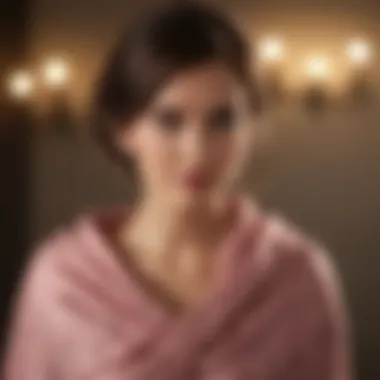Covers for Bridesmaid Dresses: A Comprehensive Guide


Intro
In the context of bridal parties, the aesthetics of the attire extends beyond the dresses themselves. Covers for bridesmaid dresses play a significant role in preserving the elegance and quality of these garments. As brides navigate the complexities of wedding planning, understanding the various cover options available becomes essential. This guide will explore the importance of these covers, reviewing styles, practical considerations, and their influence on overall bridal aesthetics.
Coverage Options
When selecting attire for a wedding, the focus is often on the dresses, but covers are vital too. They provide the necessary protection against fabric damage and maintain the dress's pristine condition.
Types of Coverage Available
Different styles of covers cater to various needs. Here are some options:
- Garment Bags: These are the most common form of cover. Usually made from durable materials, they help prevent dust and minor stains. Garment bags often come zippered and can range in size to accommodate long or short dresses.
- Protective Wraps: This option is suitable for travel. Made from lightweight, breathable coverings, they protect dresses from wrinkles and damage during transit. They are ideal for destination weddings where dresses need to be transported long distances.
- Dry Cleaners Plastic Covers: After professional cleaning, dresses may come wrapped in plastic. This provides temporary protection, but it is not advisable for long-term storage as it can trap moisture, leading to potential mildew.
Choosing the right cover depends on the specific needs of the dress and how it is stored or transported.
Liability Coverage Explained
While not directly related to the physical covers for dresses, understanding liability is important when renting or borrowing dresses. Ensuring that there is a clear agreement on liability helps manage expectations regarding damage or loss.
Key Considerations
When selecting covers for bridesmaid dresses, several factors come into play. These considerations can greatly influence the longevity of the attire.
Factors to Assess When Choosing Covers
- Material Quality: Higher-quality materials offer better protection. Check for breathable fabrics that prevent mold growth while safeguarding against dust and dirt.
- Size Compatibility: The cover should fit the dress properly. Oversized covers may fail to provide adequate protection, while undersized ones can cause wrinkling.
- Ease of Use: Covers that are easy to use and transport are preferable. Consider zippers versus buttoned options based on convenience for bridesmaids.
Understanding Policy Limits
In the event of damage, it is crucial to know what your options are regarding coverage. For those renting dresses, there may be specific limits imposed by rental agreements concerning damages or losses. Make sure to clarify these points prior to finalizing arrangements.
"Choosing the right cover for dresses is not just about style—it's about ensuring they look perfect on the big day."
By addressing these points carefully, brides and their parties can make informed choices that enhance both the preservation and aesthetic value of their wedding attire.
Intro to Bridesmaid Dress Covers
Bridesmaid dress covers are an essential aspect of wedding attire preservation and aesthetic appeal. Understanding their importance helps in making informed choices. Whether it’s about protecting those elegant gowns or matching the covers to the wedding theme, each element plays a crucial role.
Importance of Dress Covers
Dress covers serve multiple purposes for bridesmaids. Primarily, they protect the gowns from environmental factors like dust, dirt, and stains. A wedding is often chaotic, with many activities leading up to the ceremony. Keeping the dresses covered ensures they remain spotless until the big day.
In addition to protection, the right covers can also enhance the overall look. A well-chosen cover complements the bridesmaid dresses, providing visual harmony. It becomes part of the overall bridal aesthetic, contributing to photos and memories created during the event.
Even beyond the wedding, these covers help maintain the quality of the dresses for future use or resale.
Overview of Bridesmaid Dress Styles
Bridesmaid dress styles vary widely, reflecting personal tastes and the theme of the wedding. Common styles include:
- A-line: A classic silhouette that suits many body types.
- Mermaid: Fitted until the knee, then flaring out.
- Empire: High waistline, often suitable for a casual look.
Understanding these styles is critical when selecting dress covers. For instance, a long gown might require a full-length cover to avoid creasing, while a short dress could fit well in a compact design. Matching the cover to the dress style not only protects but also enhances the presentation.
Types of Covers for Bridesmaid Dresses
When selecting covers for bridesmaid dresses, there are various aspects to consider. Covers not only provide protection for dresses but they also contribute to overall aesthetics. Understanding the types of covers available helps in finding the right option that meets both practical needs and style requirements. This section delves into the different types of covers, focusing on fabric choices and styles and designs.
Fabric Choices
Cotton
Cotton is a common fabric chosen for covers due to its breathability and softness. It allows air circulation, preventing moisture buildup that can lead to unpleasant odors. Its versatility makes it suitable for various dress styles. One of the main benefits of cotton is its ease of maintenance. Machine washing is often possible, ensuring that covers can be kept fresh and clean. However, it is essential to note that cotton may wrinkle easily, requiring careful handling to maintain its appearance.
Satin
Satin offers a luxurious sheen that makes it a popular choice for formal events. It can elevate the visual appeal of bridesmaid dresses when included as a cover. Satin is smooth to the touch, providing a chic look. This fabric, however, may be prone to snagging and requires careful cleaning. Dry cleaning is often recommended, which could add to maintenance costs. The elegance it brings may justify these downsides for some users.
Tulle


Tulle is lightweight and adds an element of delicacy to bridesmaid dress covers. Its sheer quality allows for a glimpse of the dress beneath, which can be particularly appealing for special occasions. Tulle does not easily crush, making it a good option for travel. On the downside, it may not provide much warmth or protection against the elements. This characteristic makes it ideal for indoor functions rather than outdoor settings.
Polyester
Polyester covers are practical and budget-friendly. This fabric is durable, resistant to wrinkles, and easy to care for—qualities that make it a prevalent choice. It can mimic the look of more expensive fabrics like silk or satin, appealing to those on a budget. However, polyester may not be as breathable as natural fibers like cotton. This can lead to uncomfortable experiences in warmer climates. Understanding the balance between durability and comfort is vital when selecting this fabric.
Styles and Designs
Short Covers
Short covers are aesthetically pleasing and practical for warm weather. They often showcase the style of the dress while providing necessary coverage. These covers can enhance mobility, making them a practical choice for active environments. However, they may not offer as much protection during transit. Therefore, careful handling is required when traveling with them.
Long Covers
Long covers provide full-length protection for dresses. They are particularly useful for elaborate gowns that need extra care. A significant advantage of long covers is their ability to safeguard against dust and dirt during storage. On the downside, they may take up more space and can be cumbersome to transport. Evaluating the balance between elegance and convenience is essential.
Zip-Up Covers
Zip-up covers offer a secure way to protect dresses. The zipper closure prevents accidental openings, minimizing the risk of damage. This design is practical for travel as it helps to keep the dress safe from environmental factors. A potential disadvantage is that they can sometimes be bulkier compared to simpler designs. Weight considerations should be made depending on the size of the dresses being stored.
Custom Designs
Opting for custom designs allows for personalization in both function and aesthetics. These covers can be made to fit specific dress styles perfectly, ensuring that no detail is overlooked. Custom designs may also incorporate particular features, like additional pockets or special closures. However, they typically come at a higher cost and longer production time. This choice is generally most fitting for those who seek a unique solution that aligns with their specific preferences.
Functional Considerations
When selecting covers for bridesmaid dresses, functional considerations play a crucial role. It is essential to not only choose a cover that looks appealing but also one that effectively serves its purpose in protecting the dress. Different elements come into play, such as the material of the cover, its design, and how it can interact with the dress itself. The right cover will help maintain the bridesmaid dress's original condition, ensuring it looks pristine for the special day.
Protection from Damage
Preventing Stains
Preventing stains is one of the primary functions of a cover for bridesmaid dresses. Stains can occur unexpectedly from food, beverages, or even make-up. A well-designed cover made from protective materials can help in avoiding these accidents. The key characteristic of preventing stains lies in the choice of fabric. Waterproof or stain-resistant materials are particularly beneficial as they can repel spills and splashes. This feature is often appealing as it provides peace of mind knowing the dress is less likely to be stained.
Advantages include:
- Protection during transit.
- Reduced worry about accidents.
Disadvantages might be:
- These materials can occasionally be more expensive or less breathable.
Avoiding Wrinkles
Avoiding wrinkles is another important aspect when considering dress covers. The right cover will ensure that the dress remains smooth and crease-free until worn. The key characteristic of covers meant to avoid wrinkles is their structured design that keeps the dress in optimal shape. Many covers feature lining that prevents fabric from clinging, which is beneficial in reducing wrinkles.
Advantages include:
- A polished look on the big day.
- Less need for ironing before the event.
Disadvantages can include:
- Some structured designs may add bulk.
Safeguarding Against Tears
Safeguarding against tears is essential for preserving the integrity of bridesmaid dresses. The dresses often contain delicate fabrics that can easily get snagged or torn. Covers that provide protection from such damage should include durable materials and thoughtful closures. Key characteristics of these covers involve reinforced seams and secure fastenings, which help keep the dress protected.
Advantages include:
- Increased longevity of the dress.
- Peace of mind during transportation.
Disadvantages could be:
- A heavier cover might be less convenient to carry.
Ease of Transport
Efficient transport options for bridesmaid dresses should not be overlooked. Covers that prioritize ease of transport contribute significantly to the overall experience of managing the dresses before the event. Lightweight materials and design solutions ensure that moving these dresses from one location to another is simple, allowing bridal parties to focus on their roles rather than logistical issues.
Lightweight Options


Lightweight options for dress covers facilitate easy handling and transport. The key characteristic of lightweight covers is their construction from materials that do not burden the wearer while carrying. This quality is particularly appealing to those in bridal parties who may need to carry multiple dresses at once.
Advantages include:
- Reducing fatigue during transport.
- Ensuring convenience while traveling.
Disadvantages could include:
- Lightweight options might compromise some protective features.
Foldable Designs
Foldable designs enhance the transport of dress covers, making them easy to store and carry. They typically feature materials that can be compressed without losing shape or integrity. The key characteristic is their adaptability. This flexibility makes them an attractive choice for those needing to fit the covers into limited spaces, such as car trunks or travel bags.
Advantages include:
- Space-efficient.
- Versatile for different situations.
Disadvantages might include:
- May require careful handling to avoid damage.
Storage Solutions
Storage solutions are vital post-event for keeping covers safe until needed next. Optimal storage includes ensuring that the covers do not get crumpled or dirtied. The key characteristic is the design that allows for proper air circulation while shielding the dress from dust. Many covers come with built-in hangers or hooks for easy storage.
Advantages include:
- Easy organization for future use.
- Environmentally friendly materials can be chosen.
Disadvantages may include:
- Some storage solutions can be costly.
Aesthetic Factors
Aesthetic Factors play a crucial role in the selection of covers for bridesmaid dresses. They not only enhance the visual appeal of the wedding but also contribute to the overall theme and atmosphere of the event. When choosing covers, elements like color coordination, style, and how they align with the wedding theme should be considered. These factors elevate the bridesmaid experience and help create a cohesive aesthetic that complements the wedding's vibe.
Color Coordination
Matching Bridal Colors
Matching Bridal Colors is essential in achieving a harmonious look throughout the wedding. When dresses for bridesmaids align with the bridal colors, it creates a sense of unity. A key characteristic of this approach is that it emphasizes the bridal palette, connecting the bridal party with the bride. It serves as a visual reminder of the main celebrant, making the photos more cohesive and pleasing to the eye. However, excessive matching may limit personal expression among bridesmaids.
Neutral Options
Neutral Options offer versatility and elegance when choosing covers for bridesmaid dresses. These tones can complement any color scheme without overshadowing the main elements. Their key characteristic is adaptability, which appeals to many brides. Neutral covers allow bridesmaids to maintain their style while fitting into the overall aesthetic of the wedding. However, some may find neutral solutions too plain or lacking personality.
Seasonal Palettes
Seasonal Palettes provide a fresh perspective on the choice of covers. Selecting colors that match the season enhances the ambiance of the wedding. Key characteristics of this approach include vibrancy and appropriateness. For example, spring may inspire pastels, while autumn embraces rich earth tones. This strategy aligns with nature's beauty, making it a popular choice for outdoor weddings. However, one challenge includes ensuring these colors also suit the diverse preferences of each bridesmaid.
Enhancing the Wedding Theme
Formal Themes
Formal Themes demand sophistication and elegance in all aspects, including bridesmaid covers. These covers often display luxurious fabrics and structured designs, essential in achieving the desired aesthetics. This approach is beneficial as it reinforces the decorum and grandeur of the event. Unique features include detailed embellishments or tailored fits. However, a downside might be that formal covers limit the comfort levels of the bridesmaids.
Casual Themes
Casual Themes invite a relaxed atmosphere where bridesmaid covers can reflect a laid-back vibe. The key characteristic here involves comfort and ease of movement, aligning with the overall sentiment of the celebration. Casual covers can enhance the appeal by incorporating fun patterns or lightweight fabrics. A disadvantage might be the potential lack of formality that some weddings might require, which could affect the overall bridal aesthetic.
Bohemian Styles
Bohemian Styles embrace free-spirited and unconventional designs. This specific aspect is significant as it encourages individual expression among bridesmaids. The key characteristic of Bohemian covers includes flowy silhouettes and earthy tones, creating a whimsical charm. Their unique feature allows for the incorporation of diverse patterns and materials. However, they may not fit well in very formal weddings, potentially clashing with the intended theme.
Practical Tips for Selection
Selecting the right covers for bridesmaid dresses involves careful consideration to ensure both functionality and style align with the needs of the bridal party. This section emphasizes the significance of practical tips and how they aid in making informed choices. By understanding the materials, budgeting options, and specific requirements of dress covers, brides and their teams can achieve a balance between protection and aesthetics.
Assessing Dress Material


Understanding Fabric Needs
Understanding fabric needs is crucial when selecting covers for bridesmaid dresses. Different fabrics are not only about aesthetics but also about how they interact with the dress itself. For example, breathable materials are necessary for preservation, especially during warmer months. A key characteristic of different fabrics is their ability to protect against moisture, dust, and other environmental factors.
In this context, suitable fabric choices, like cotton or satin, make the dress covers both functional and pleasing to the eye. Cotton allows air circulation, helping to prevent mildew formed due to trapped moisture. On the other hand, satin may add a touch of luxury but might not provide the same level of breathability. Understanding these nuances can guide brides in selecting covers that ensure optimal protection while also complementing the dress's aesthetic.
Matching Weight and Texture
Matching weight and texture is another essential element in selecting dress covers. The weight of a fabric contributes to its protective qualities. Heavy fabrics may provide more durability and protection against potential damage but can lead to bulkiness, which is less practical for transport.
A light texture, like chiffon, might keep dresses safe from wrinkles but could offer less protection overall. The unique feature here is the balance required between lightweight designs for ease of transport versus heavier options that offer superior protection. This consideration directly impacts how dresses are maintained during events and travel.
Budget Considerations
Cost-Effective Solutions
Cost-effective solutions are vital for bridesmaids and the bride when choosing dress covers. Many affordable options provide adequate protection at lower prices, which is an attractive prospect for budget-conscious parties. For instance, opting for generic covers made from polyester might not have the same aesthetic appeal as designer alternatives but offers substantial protection against stains and wrinkles.
These solutions often come in bulk, making them economical for larger bridal parties. Additionally, opting for less expensive materials doesn't always mean sacrificing quality. The real advantage stems from the ability to represent your style without overspending on the overall wedding budget.
Custom vs. Store-Bought Options
The choice between custom versus store-bought options highlights another important consideration. Custom dress covers allow for greater personalization, fitting perfectly to any dress style or color. This tailored approach brings a unique charm, ensuring each bridesmaid’s attire is well-protected while harmonizing with the wedding theme.
On the other hand, store-bought options provide convenience and accessibility. They can often be found quickly and are available in various styles, which simplifies last-minute preparations. However, customization offers a distinct advantage of ensuring covers match the specific needs and tastes of the bridal party. Weighing the pros and cons of both choices ensures that the selected cover aligns with the overall wedding vision.
Care Instructions for Dress Covers
Proper care for bridesmaid dress covers is crucial. It ensures that these protective garments maintain their functionality and appearance over time. For brides and their parties, understanding care instructions can save money and effort in the long run. Here, we discuss the essential cleaning guidelines and storage practices that keep your dress covers in optimal condition.
Cleaning Guidelines
Hand Wash vs. Machine Wash
Hand washing is often considered gentler on fabrics. When it comes to delicate materials frequently used in bridesmaid dress covers, hand washing minimizes the risk of damage. This method allows for more control over the process, leading to fewer chances of stretching or tearing. Additionally, using cool water and mild detergent can safely remove dirt without fading colors. However, it can be time-consuming.
On the other hand, machine washing offers convenience. Many modern machines have delicate cycles designed for gentle fabrics. This makes it a viable option for those who prefer efficiency. It is essential to read care labels to ensure that the dress cover can withstand machine washing. Using laundry bags can also prevent snagging.
Dry Cleaning Advice
Dry cleaning is often recommended for intricate covers. This process uses solvents that lift dirt without water, preserving the fabric's integrity. For materials like silk or heavily embellished covers, dry cleaning can prevent damage that water might cause. Although it is a bit more costly, the results can be worth it, particularly for unique pieces. However, regular reliance on dry cleaning can lead to fabric wear over time.
Storage Practices
Optimal Conditions
Storing dress covers correctly prolongs their life. Optimal conditions include keeping them in a cool, dry place away from direct sunlight. Humidity can lead to mold or damage, while sunlight can fade colors. Additionally, using breathable garment bags avoids dust build-up, which can mar the fabric surface. It is advisable to avoid plastic covers since they can trap moisture. A fabric cover is recommended to maintain the fabric's quality.
Seasonal Rotation
Seasonal rotation is an effective practice for managing your dress covers throughout the year. This involves adjusting the storage based on the season. For instance, store heavier fabrics in the colder months and lighter materials when it is warm. It helps in utilizing space efficiently while keeping dress covers in top shape. Furthermore, regularly checking the conditions of the covers throughout the year ensures that any issues are addressed promptly.
Proper care instructions help maintain the quality of bridesmaid dress covers, extending their usability and beauty.
By adhering to these care instructions, brides and their parties can ensure that their bridesmaid dress covers remain functional and stylish, enhancing their overall wedding attire.
The End
The conclusion serves as a pivotal section in this article, providing a synthesis of the information presented throughout. It reinforces the significance of choosing suitable covers for bridesmaid dresses, ensuring that both functionality and aesthetics are considered. Selecting the right covers contributes not only to the preservation of the dress but also to the overall visual appeal of the bridal party.
Recap of Key Points
In this article, several critical aspects were discussed regarding bridesmaid dress covers:
- Importance of Dress Covers: Providing protection, allowing for ease of transport, and enhancing the overall look.
- Types of Covers: Various fabrics like cotton and satin, along with different styles such as zip-up covers and custom designs.
- Functional Considerations: Factors like protection from damage, ease of transport, and storage solutions were vital.
- Aesthetic Factors: Coordination with the bridal theme and color palettes.
- Practical Tips for Selection: Assessing material, understanding budget considerations, and how to care for the covers.
Readers now have a comprehensive understanding of how to select the right covers tailored to their needs and preferences.
Final Thoughts on Selection
Choosing the ideal cover for bridesmaid dresses is not merely about protecting the attire. It is about ensuring that every detail aligns with the wedding’s vision. The right cover enhances not just the dress but uplifts the entire bridal aesthetic. Fashion and function go hand in hand.
Brides and their parties should take the necessary time to evaluate their options. Consider dress materials, the potential for customization, and how each cover complements the overall wedding theme. Informed choices yield beautiful results, contributing to a memorable wedding day.
"Every detail matters when crafting a perfect wedding, from the dresses to the covers that protect them."
Linking functionality with aesthetics is essential in making thoughtful selections. The right bridesmaid dress covers provide peace of mind, protecting invaluable dresses while adding a layer of sophistication to the wedding look. This duality makes the process of selection not just practical but also an important aspect of the wedding planning journey.



